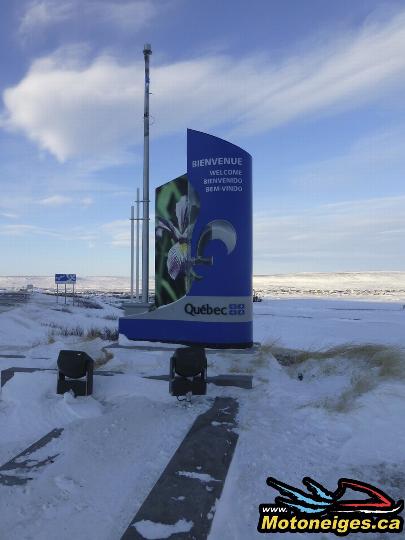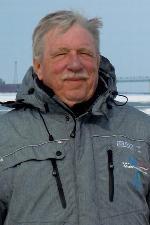Table of contents
ToggleBlanc-Sablon is a flat rock, covered with mosses and low trees. This is how our ancestors described this nordic coastal landscape. It even seems that some of them used tree roots as firewood because wood was really a rare commodity.

Here, we are on the border of Québec and Labrador, in the Gulf of St. Lawrence, facing Newfoundland littoral that we can easily see. From Natashquan and Kegaska, the Route 138 ends up and only snowmobile can take us along coast to visit the 14 remote villages apart from each other by sea, bays and large peatlands.

As soon as January 15th, these communities stop receiving their supplies by sea from Rimouski. The N/M Bella Desgagnés, that replaced the Relais Nordik to provide services to communities located along the coast of 900 milles/1 448 kilometers, is stored for winter. Snowmobile is then the only way to move by land over the 500 km between Natashquan-Kegaska and the Labrador borders. Around January 15th, the Route Blanche is officially open; it will allow villagers to get around, to visit and to make contact until the arrival of Canada geese in May, just before the return of the N/M Bella Desgagnés.

The trail of village festivals
The opening of the Route Blanche is the beginning of a long season of exchanges and festivals for these people. Unlike what we think, it is during summer that the villages are isolated. The long bays, peatlands, rivers are now frozen till the end of April and suddenly, the Route 138 extends and will melt away while the usual fishing and business seasonal operations will start again.

In winter, the number of residents in many of these small villages increases because seasonal workers who must work away from home, are back here. They use this period to repair their fishing gear, to find, to cut and to prepare firewood for the next winter and to be part of the community and sport events.

Pick-ups arrived by boat are stored where snow blocked them. They will start again when snow will be melted. Now, snowmobile is queen. Streets become trails and many snowmobiles are parked in front of each home ready to get around. Hockey tournaments can now be disputed and competition between villages requires several trips. Parking lots around skating rinks and arenas are filled with snowmobiles. Before or after the game, people gather in a restaurant also accessible only by snowmobile. They go ice fishing as well as trapping on snowmobile.

Snowmobile is queen
Every aspect of life depends on snowmobile transportation. It is used to go and get the mail and to chat with the post clerk. Parcels containing the online purchases can then be taken back home strongly tied up. If the family needs food, people will go by snowmobile to the local grocery or to the grocery in a neighboring community. Sometimes, you need a sleigh to bring back your purchases. We often see 2 adults plus 2 children seated on the same snowmobile. They do not ride fast, but still it is better than snowshoes or antique dogsleds. Today, snowmobiles are reliable, even more reliable and of greater endurance than dogs. These ones are also retired and they are very happy to see visitors. Sometimes, the whole pack of adult dogs and their puppies welcome you, hoping to be petted. They are like people, happy to welcome you.

Some families will even be able to show you pictures of a bride all dressed in white, getting to church on a snowmobile. Funeral cortege with snowmobiles and sleighs, workers, in brief, it is also the reality of streets not cleared of snow.

An injury or a sudden sickness? You will go to the village clinic by snowmobile and with few resources, the nurse will take care of you. No delay, no triage, no number; you just parked your snowmobile and she is already giving you the medical assistance you need. Your snowmobile engine will still be warm. If required, she will see you again the day after, following a good night in these small northern hotels and boarding houses. Hard to believe that snowmobilers from the cities are afraid of the remoteness of Côte-Nord. Personally, it is the isolation in emergency triage areas of the big cities that scares me.

In small communities, the mechanic in his workshop knows everything about snowmobiles as it is the only possible transportation. He keeps parts in stock or he will manage to make one himself that will do the job until you get to the closest dealer. You must be resourceful and imaginative to live here. You can easily find gas and oil because every family owns many snowmobiles. Winter reserves have been supplied by the N/M Bella Desgagnés and should meet the needs.

Lodging accomodations and gastronomy to discover
There is no big hotel, no hotel chain either, only small inns or boarding houses, gites that offer meals and charming cozy bedrooms. No extra fees for a view on the sea. The traditional cooking will make you discover the chitouté served on breakfast crepes, the seal oil croquignoles, the regional fish and seafood sometimes frozen, canned or smoked, served in pies, meats being rarely found in grocery store, in brief, memorable meals. Some small restaurants also offer French fries and sauce, but they are famous for their seafood pizza or their crab club sandwich or stir-fry scallop. The very tasty local fast food will please the most demanding nutritionists. In other words, it is comfort food!

And what about the snowmobiler?
Visiting Minganie means to discover places that were inhabited a long time before Jacques Cartier arrived. Europeans came here for whale and seal hunting, to bring back oil and fish, in short, to feed people on the old continent. Over the centuries, these villages of fishermen, hunters, trappers and gatherers have been organized and there were more residents than today who also worked in fish plants. Lots of people earned their revenues from these resources and they must now find seasonal work outside their region.

However, Côte-Nord inhabitants always keep their deepest roots and everybody helps keeping the villages alive, for example by offering services to tourists who want to discover the secrets of Gilles Vigneault’s village. Also, the site of the movie Seducing Doctor Lewis (La grande séduction) on Harrington Harbour Island with its Rowsell House Interpretation Centre and pensions, the welcoming village of Chevery with the Ana Osborne guided tours.

The Innu Unamen Shipu reserve located on the confluence of La Romaine River is also on the Route Blanche. This village is the largest Innu community with over 1 200 residents. Various lodging and supply services are available here along with the possibility to be part of their traditional and cultural activities. Experiencing the sweat lodge ritual, visiting the church with its pieces of art or purchasing Innu handicrafts in their home, are great activities you do not want to miss.

Then, we see the villages of Baie des Moutons, La Tabatière, Tête-à-la-Baleine and its archipelago with hundreds of islands that are still inhabited in season and where you must enjoy a guided tour on trails riding on frozen sea. Jos Hébert’s island and house, mail carrier for the entire Côte-Nord who often slept under his sled with his dogs during a storm and waited for clear sky to deliver mail all over the region. Providence Island, its chapel and presbytary are also places you must discover. Martin Marcoux, innkeeper in La Tabatière, will guide you and make you discover this large archipelago and all the local facilities.

Saint-Augustin is a village of 800 residents where you will find an inn and the famous and very busy Restaurant des Soeurs. On the other shore of this salmon river, a community of more than 300 Innus or Montagnais live here in their traditional lifestyle and they are very proud to keep their language and traditions alive. Over 700 people live in Rivière-Saint-Paul, a village that was famous for the prime quality of fishing in its bays and its archipelago. A very interesting small museum is open on demand and Mr Nadeau, the local guide, uses the various objects to explain the old ways of fishing, the boats and the evolution of this industry since a few hundred years. Finally, after riding through the village of Vieux-Fort, the trail arrives in Blanc-Sablon, the administrative centre of Minganie, with over 1 000 inhabitants.

Then, we arrive in Lourdes-de-Blanc-Sablon where we find many lodging accomodations such as the Hotel/Motel Blanc Sablon and the Auberge Motel Quatre Saisons operated by Gary Landry. There is also the Arctic Cat dealer, Sport Max Location. Mr Yves Lévesque, the owner, also offers car rental if you want to visit Labrador villages and enjoy the view of the Côte-Nord. From Blanc-Sablon, snowmobilers can also have access to the well maintained trails in Labrador up to Red Bay or else, use the ferry to Newfoundland. Finally, we must say that it is on Greenly Island, facing Blanc-Sablon, that the first transatlantic flight from Ireland ended on April 12, 1928.
A very well-kept secret!
Snowmobiling in Minganie means being part of the Coasters’ lifestyle, who got attached to these exceptional wilderness sites.

Two ways to get there
You can take trail #3 that runs along the north shore of the St. Lawrence River up to Tadoussac and from here, you ride on well maintained 1 671 kilometers of federated trails up to Blanc-Sablon. We can also leave from the end of Route 138 in Natashquan or Kegaska.

Another and fastest way is to flight with Provincial Airlines to Blanc-Sablon and enjoy the lodging, snowmobile rental and guide package to discover Minganie and its 500 kilometers. If you choose this option, you must contact the COSTE cooperative located in Rivière-au-Tonnerre; they will plan for you a customized adventure in this nordic paradise where snowmobile is queen.



